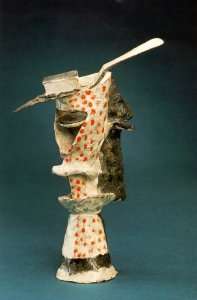Pablo Ruiz Picasso
 |
"Sometime in the spring of 1914 Picasso made a wax piece of sculpture of an absinthe glass, which seems very different from his other constructions of that spring like the relief of "Glass and Die". The wax was not in itself very large - about 8 1/2 inches high. It was unusual in having been modeled, so that the artist's finger marks are detectable, instead of having been constructed, and in having been conceived in the round instead of as a relief. Picasso did several disturbing things with his sculpture at this stage. One was by denying the capacity of the glass to hold liquids by opening up one wall of the upper part of the goblet so that any absinthe would pour like a fountain into the basin he built at the top of its base. The second was to treat the glass like a highly distorted human head, the opening in the wall the equivalent of a human eye with a great projecting eyelid, which is repeated on the opposite closed side of the "face" as well, by modeling a great nose which begins between the two eyes but swings boldly to the open area and projects great upper lips which would interfere with the movement of absinthe to the basin of the lower lips below. The conical base is the neck. Although the top of the head or glass was left open, it was to be provided with a hat, made of a silver absinthe spoon and a bronze cube of sugar. Kahnweiler had six bronzes cast from the wax model, the wax disappearing in the casting; and Picasso painted each quite differently.